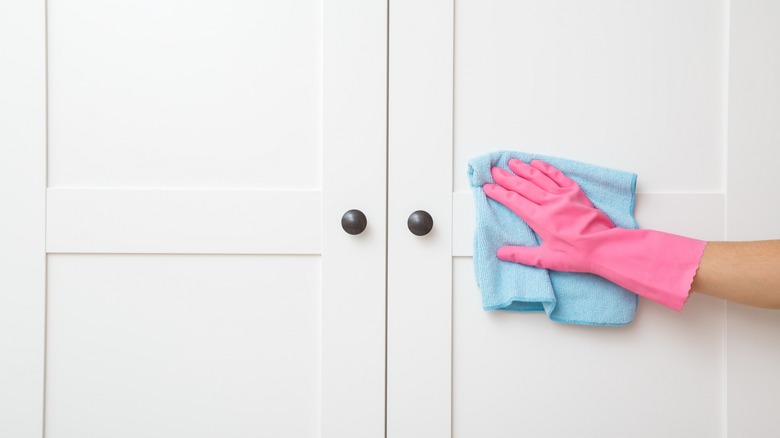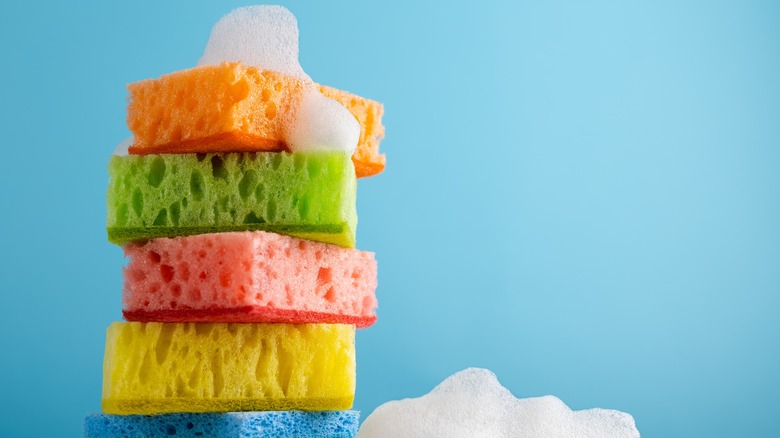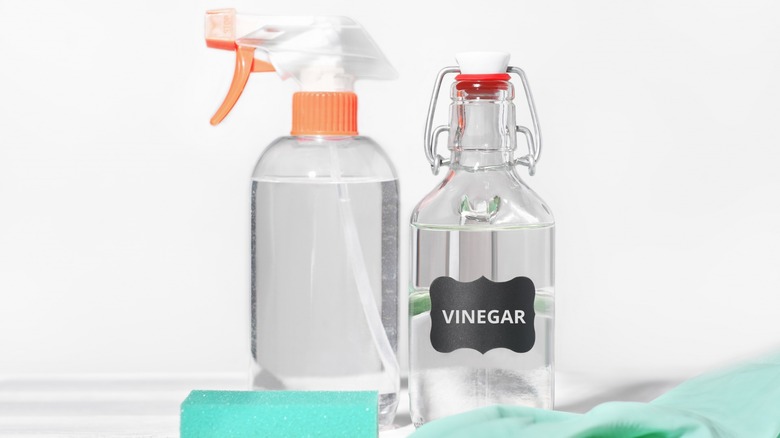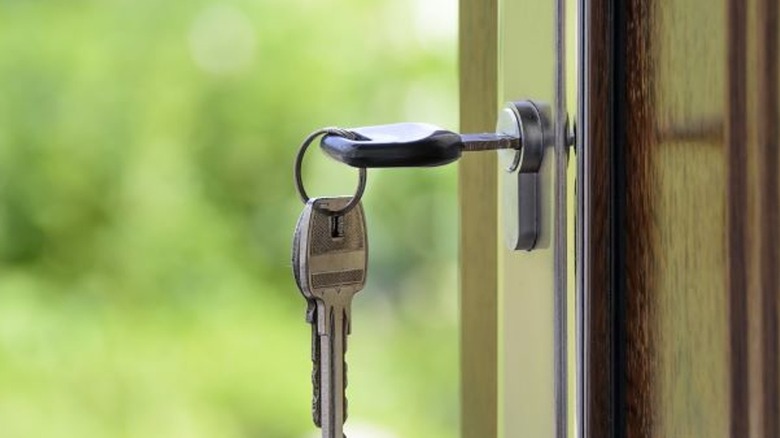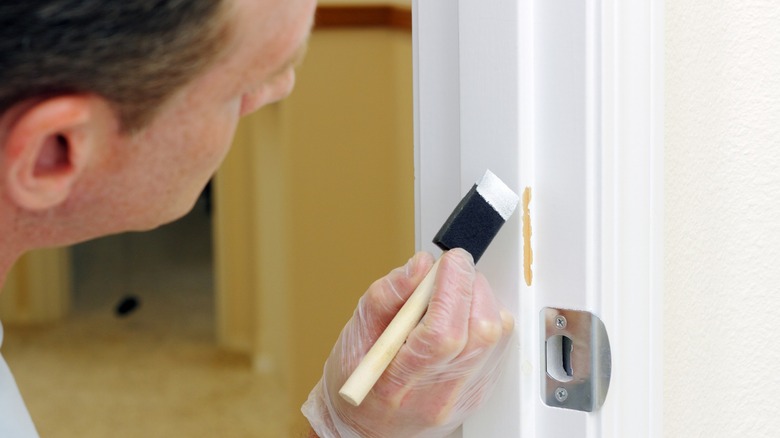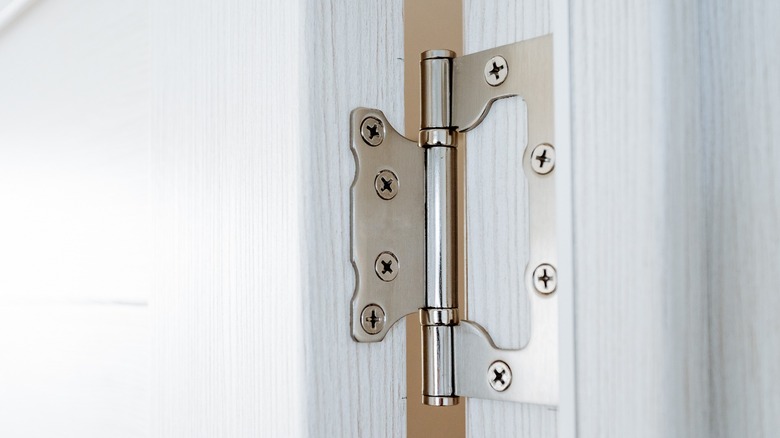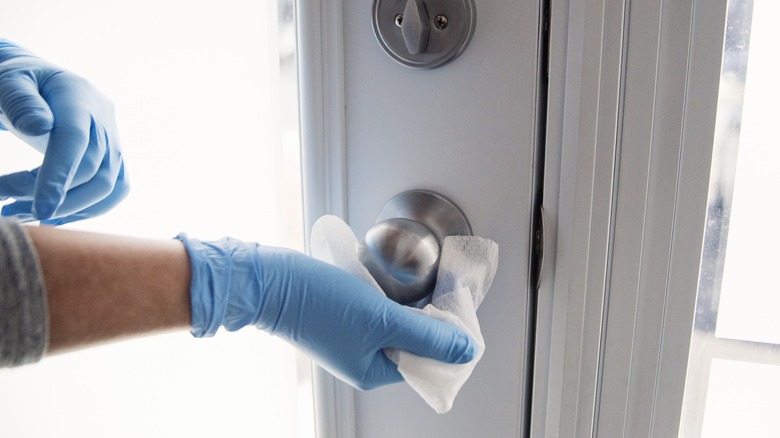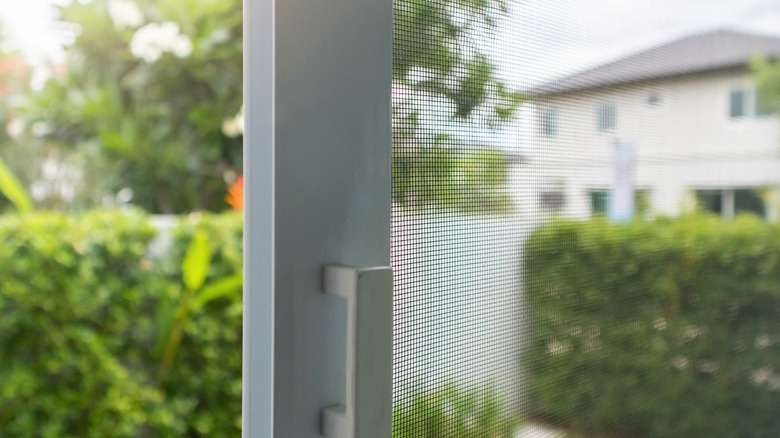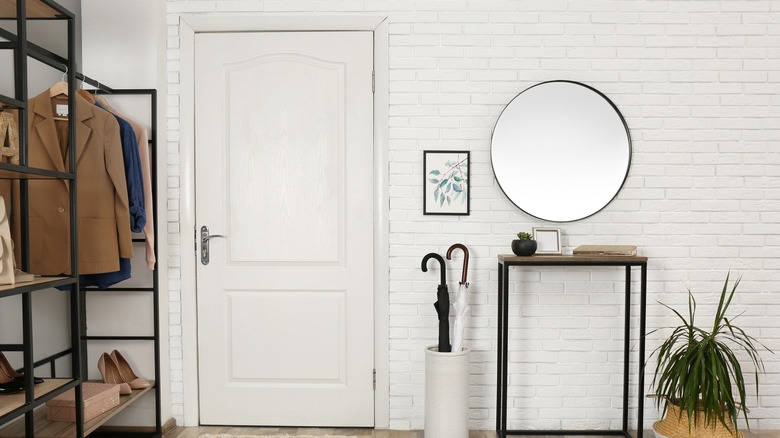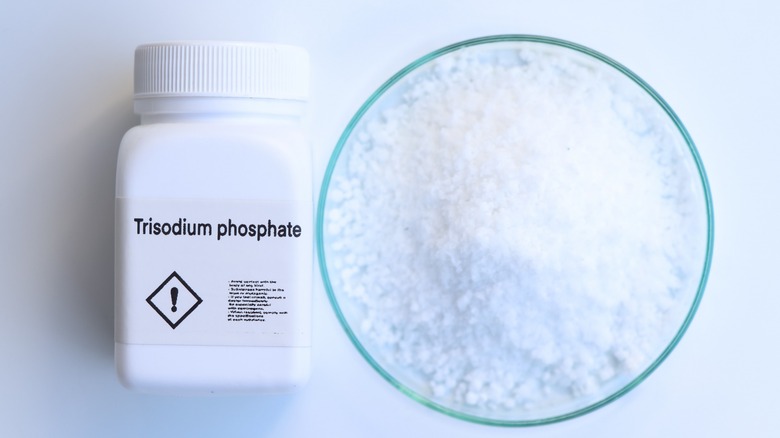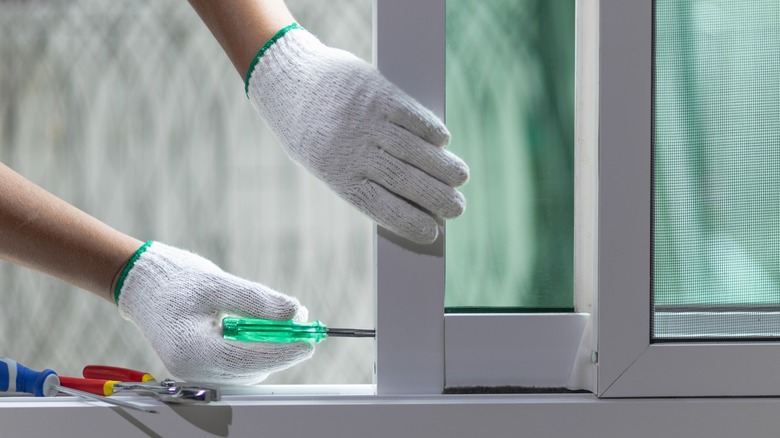Cleaning Tips To Make Your Doors Seem As Good As New
Homes and offices typically have many doors, yet they often don't look as great as they should. Dirt and grime accumulate over time, making doors look old and dingy. This can also prevent them from opening and closing smoothly. A proper cleaning will make them seem as good as new but it involves more than just a quick wipe-down.
Like switchplates and computer keyboards, doors are high-touch surfaces that get covered in fingerprints, grease, and dirt. It's common knowledge that they also harbor germs and bacteria that can spread to other people and places. But to make a door look new again you should consider all the parts, from the frame down to the knobs. This applies to the front and back, whether it's an interior or exterior door.
The smartest way to tackle this project is to set aside some time to clean all the doors in the house instead of just doing one or two. Gather the appropriate cleaning supplies and tools for the type of surface and move from room to room. And don't forget the closet, cabinet, and refrigerator doors – they also deserve to look and work like new.
Dust it thoroughly
Wetting dusty surfaces and wiping them down is inefficient because it smears grime around. Instead of subjecting your doors to that, dust them first. An easy way to do this is with a clean, dry microfiber cloth or mop. Rags and dusters tend to push the particles into the air instead of removing them. If you can't reach the top of the door, stand on a step stool because there may be hidden dust and cobwebs there. Start on the top and work your way to the bottom. If the microfiber doesn't get into the crevices, use a soft toothbrush or a clean paintbrush.
For doors that haven't been dusted in ages, lay down an old towel on the inside floor and consider wearing a mask. A hand vac or vacuum hose attachment can also help with floor cleanup; you won't want to track the dust on your path to the next door.
Try dish soap, Murphy's oil soap, and vinegar on wood doors
Painted and stained wood doors are durable and sturdy but must be cleaned with gentle products and tools to prevent damage. Harsh products can strip paint, so combining a few drops of gentle dish soap and Murphy's into a bucket is safer. Pour in warm water until it bubbles up a bit but don't make it too soapy, or it will take longer to clean and could leave a film. And if the door is especially dirty, add about ½ cup of vinegar to help break up the grime.
You'll want to use a fresh sponge, microfiber cloth, and toothbrush or paintbrush for this part as well, taking care not to rub the wood too hard. Never use scrub brushes on wood doors. After the surface is clean, dry it with a towelbecause wood is porous and residual moisture could get absorbed and cause it to warp. Once it's dry, you can polish the door with liquid spray wood furniture polish. Spritz some onto a cloth and rub it in the same direction as the grain.
Use vinegar on fiberglass doors
Fiberglass doors also stand up to the elements and can be more wallet-friendly, but can get scratched just as badly as wood ones. Regular cleaning with a damp rag is fine but a deep cleaning will produce newer-looking results.
Combine one cup of plain white vinegar and a gallon of water to clean fiberglass doors. Feel free to pour some into a spray bottle and use a sponge or lint-free cloth to wipe down the door. If any stains are left, spritz the mixture onto them and let things rest for about 10 minutes. Scrub gently with a soft-bristled brush rather than an abrasive cleaning tool. And if the door smells for any reason, empty the spray bottle and add four tablespoons of baking soda. Fill it up with some of the remaining vinegar mixture and use it on both sides of the door to make it smell brand-new.
Clean steel doors carefully
Steel and metal doors are vulnerable to rust , so they are often painted. It's important to check them regularly and remove any visible corrosion before it has a chance to build up. Try softening it with an old towel dampened with kerosene. Then, carefully scrape it away with sandpaper. These doors can be cleaned with alcohol-based solutions or a regular household cleaner applied with a cloth. After that, wipe it down with water and dry it completely.
Stainless steel doors must be treated differently. They are made with a protective covering of chromium oxide that resists rust. But they are more prone to showing fingerprints and smears that mar their pristine appearances. Using the wrong cleaning supplies can cause permanent scratches and make them look old, so never use harsh ones like ammonia or steel wool. Glass cleaners that don't have vinegar or ammonia are safe, or just use a teaspoon of dish soap mixed into hot water. To add shine, apply a thin coating of mineral oil.
Attend to that sticky door lock
A sticky door lock is more of a functional problem than an aesthetic one: It can make it impossible to secure the door and keep you from getting into your house. Cleaning the keys can help but attending to the inside parts of the lock itself will solve the problem. It starts when dirt on the outside of the door finds its way into the chamber located within the internal locking mechanism. But it doesn't have to stay there.
Locksmiths use powdered graphite for this purpose. It's sold in hardware stores but buying that isn't necessary because a can of compressed air works just as well. The debris can also be removed with a thin wire guided into the lock opening. If the key still doesn't go in smoothly, try rubbing the end of a pencil all around the sides. Keep inserting it in and out of the lock until there are no obstructions.
Clean and shine windows and glass sliding doors
Inset door windows let in the sunshine unless they are dingy and dirty. It's best to clean the windows after you tackle the rest of the door, because the cleaning liquid you use on the door will drip down, and you'll need to wipe and dry everything again. You can use a favorite glass cleaning spray but a homemade one works just as well: Pour a ¼-cup of rubbing alcohol and three tablespoons of vinegar into a spray bottle and add water.
The best way to clean windows without streaks is to wipe the glass down with a coffee filter or microfiber towel. Some people like using newspaper for this, but it could leave black marks on the door and your hands. If the stains haven't come clean, you may need to resort to another method. Get some fine sandpaper or steel wool and gently rub until the marks loosen up, and try cleaning the windows again.
Glass sliding doors can be cleaned with soapy water and a rag first to break up the dirt. The outer side can be rinsed off with the hose to save time but dry both sides well before proceeding to the next step. Use a regular window washing cleaner and a foam sponge to shine the glass, but wipe it down right away with a squeegee. This is the fastest way to dry large surfaces and won't leave any streaks.
Eliminate door scratches and scuffs
The method for cleaning up a scratch depends on what the door is made from. For steel doors, wipe the area down with soapy water and dry it well. The scratch can be filled in with an exterior-grade paint that's designed for steel, but read the label to ensure that it's rust-proof. Test it on a hidden area first to ensure that the color matches, apply it, and allow the paint to dry. Fiberglass door scratches can be cleaned and repaired in the same way, with a bottle of touch-up paint that's compatible with this material. Use a little bit of it at a time, feathering out the edges for a smooth finish.
Wooden door scuffs can be buffed out with a cloth or removed with Magic Erasers when they aren't deep, or you can mix up a cleaning paste. Add a bit of water to a tablespoon of baking soda to get the right consistency and apply it to the marks. If the scratches are too deep, smooth the area around it with fine sandpaper, clean the dust, and repaint it.
Do a good job on the doorframe
The majority of residential doorframes are made from wood but are sometimes made from other materials. They often get neglected on cleaning day and that's a mistake because they can be covered with fingerprints and grime, especially close to the doorknobs. The individual sides and tops are called door jambs – perfect places for dirt and debris to remain hidden from sight.
The fastest and most effective way to make those door jambs as good as new is with a basic dish soap and warm water cleaning solution after they've been dusted. Apply it with a cloth or sponge all the way around, on both sides, paying attention to the narrow areas. Do another pass with clean water until all the residue is removed. If there are any stains left standing, they can usually be zapped away with vinegar and water. After that, dry the doorframe and use wax or polish to make it shine.
Remove buildup on hinges
Doors are attached to frames with screwed-on attachments and the most common kinds are butt hinges. They can be cleaned and shined with a cleaning solution but removing them works better when the goal is to make them look like new. Unscrew them from the frame and place the door somewhere safe so it won't fall. Fill up a bucket with soapy water and drop the hinges in there. Wait half an hour, and scrub the hinges with an old electric toothbrush head – this is the best way to loosen the grime.
Since not everyone has one of those, a baking soda paste and a plain toothbrush can be used instead. Rinse the hinges when finished and dry them. And if you notice any corrosion, use sandpaper to remove it and wipe them down afterward. Reinstall the clean hinges and test the door to make sure that it moves smoothly.
Polish and disinfect the hardware
Door handles, knockers, and knobs are the first things people see when they go to open or close a door, so rest assured that unclean ones get noticed right away. They're usually made out of metal, with common finishes like brass or chrome.
If the hardware is made from nickel or stainless steel, apply a light coating of wax after cleaning and drying. Brass tends to tarnish, but that can be removed by applying and buffing out a lemon juice and baking soda paste. Tarnished silver and silver-plated knobs should be removed and placed in aluminum trays. They get covered with baking soda and boiling water, and after things cool off, they can be wiped with a lint-free cloth.
Pewter door hardware can also be given special treatment with a cleaning paste, but make it with a cup of vinegar, one teaspoon of salt, and a bit of flour. That should sit on the hardware for 15 minutes before buffing. As the final touch, quickly disinfect the hardware with sanitizing wipes.
Vacuum and scrub screen doors
Screen doors are made to keep debris and dust from getting inside and should be cleaned regularly and carefully to maintain their good looks. Many people remove them first but this isn't necessary as long as you don't use too much pressure and pop the screen out from the door. Use a vacuum hose attachment with a brush end to gently suck up dust from both sides of the screen. Next, dip a bristle brush into a bucket of soapy water and gently scrub the surface from top to bottom. Remove the residue with a clean, wet sponge and let the screen air dry.
If you removed the screen door, the work can be done outside and you won't need to worry about dirtying up the floors. There are other pros and cons to doing this, too. It takes longer to remove and reinstall the screen and it might need to be adjusted once it's reattached. But it's easier to clean the frame thoroughly when it's taken off and the dust doesn't get pushed into the house.
Make a white door sparkle with baking soda
Bright white is one of the most common colors for doors, particularly interior ones. That lightness makes them show more dirt and besides that, they can take on an unattractive yellowish tinge over time. Few things age a door's appearance more quickly than that, but a clever cleaning tip can return them to their original color.
After the door is dusted and cleaned, mix up a few drops of gentle dishwashing liquid, ½ cup of baking soda, and ¼ cup of water in a container. This paste can be applied onto the yellowed areas and worked in with a clean sponge or toothbrush. After about 10 minutes, remove it with a damp towel. Always do this in a well-lit area, because dimness can mask the yellowness and you want to remove as much as possible. If the discoloration remains, repeat the process a second time.
Try stronger cleaning agents
When you have tried several methods to remove door stains unsuccessfully, trisodium phosphate (TSP) can be used as a last-ditch effort. This strong cleaning agent is safe for certain surfaces and is effective on mold, but should not be used on glass, metal, or hardwood. And if it's used on a painted door, the surface won't be as shiny afterward. It is highly effective on tough stains though, and may be worth trying.
It's sold as a dry powder that gets mixed in different ratios with hot water. Be aware that it requires certain handling precautions and also contains phosphates that are not environmentally friendly. It is illegal to use it in detergents in most of the country, but TSP substitutes are available. You must wear personal protective equipment when using TSP, so put on gloves, a respiratory mask, and safety goggles, and don't leave your arms or legs exposed. Mix ¼ cup of the powder with 2 gallons of water and cover up any nearby areas that could be damaged. If TSP seems too risky, use borax or Simple Green.
Remember to clean out sliding door tracks
Sliding doors can look clean and sparkly but won't seem as good as new or work right unless the tracks are clean and smooth. To clean sliding door tracks, use a broom to get in there first, and follow up with a vacuum hose attachment. Then, dig in with a damp cloth, toothbrush, and soapy water – rinse with water when finished. If that didn't do the trick, sprinkle baking soda into the tracks and spritz with hydrogen peroxide or vinegar. After it fizzes up, go to work with the toothbrush. Get into all the narrow spots and don't forget to clean the locking mechanism.
It's a good idea to remove the doors once in a while for a more thorough track cleaning; this will also help it move more easily. Set out a few blankets on the floor and use a screwdriver to remove the door from the track. Some slider doors aren't attached with screws and can just be pulled up and towards the body. After the door is set down, clean the tracks from end to end and then clean the bottom of the door frame and wheels. And before reinstalling it, lubricate the tracks. The doors will look and work like they were just bought.

